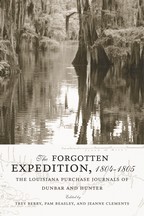
288 pages / 6.00 x 9.00 inches / 3 Halftones, 1 Map
History / United States - Southern History
At the same time that he charged Meriwether Lewis and William Clark to explore the great Northwest, President Thomas Jefferson commissioned William Dunbar and George Hunter to make a parallel journey through the southern unmapped regions of the Louisiana Purchase. From October 16, 1804, to January 26, 1805, Dunbar and Hunter, both renowned scientists, made their way through what is now northern Louisiana and southern Arkansas, ascending the Ouachita River and investigating the natural curiosity called "the hot springs." Though Dunbar and Hunter's journals have the same value and appeal as Lewis's, theirs have long been out of print and have never been published in a single volume. Their daily accounts now appear together, enhanced by a wealth of useful notes.
The team of the "Grand Expedition," as it was optimistically named, was the first to send its findings on the newly annexed territory to the president, who received Dunbar and Hunter's detailed journals with pleasure. They include descriptions of flora and fauna, geology, weather, landscapes, and native peoples and European settlers, as well as astronomical and navigational records that allowed the first accurate English maps of the region and its waterways to be produced. Their scientific experiments conducted at the hot springs may be among the first to discover a microscopic phenomena still under research today.
The Forgotten Expedition completes the picture of the Louisiana Purchase presented through the journals of explorers Lewis and Clark, Zebulon Pike, and Thomas Freeman and Peter Custis. It is a treasure of the early natural history of North America and the first depiction of this new U.S. southern frontier.
"Set out at half past six a.m. The morning very foggy on the river & not so cold as yesterday. The banks still rising in height by slow degrees & the land more & more intermixed with sand…. Found on the bank a young Fawn just killed by a Panther, the throat being tore very much. We took it on board & made a hearty meal of it, or two for all hands."
Pam Beasley is the director of the Arkansas Museum of Natural Resources in Smackover, Arkansas.
Jeanne Clements retired as director of the Arkansas Museum of Natural Resources in 2003. She lives in Tucson, Arizona.
Found an Error? Tell us about it.